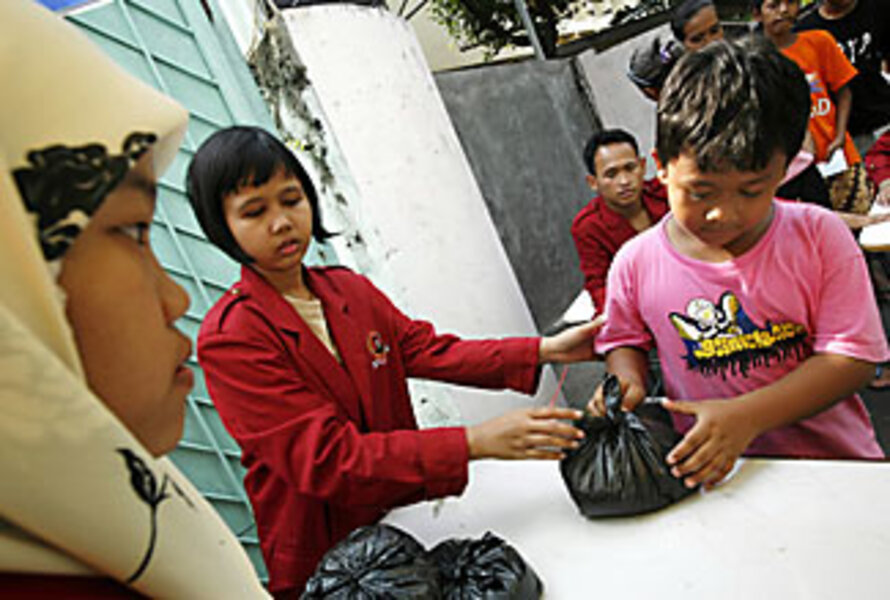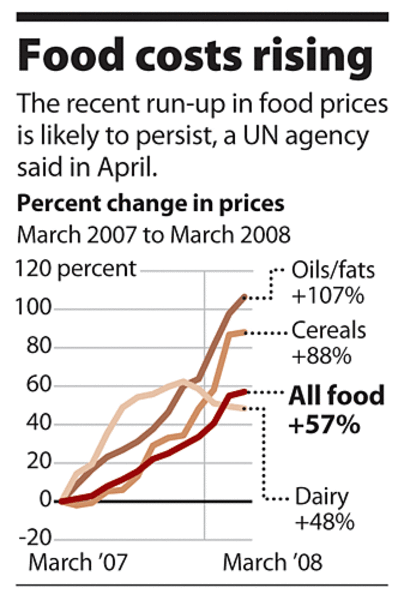Rising price of rice keeps U.N. scrambling to feed world's hungry
Loading...
Thomas Keusters bought several tons of rice in January, as he has done every year for the past three that he has been at the helm of the World Food Program (WFP) office in Cambodia. He thought he was set.
The United Nations' WFP helps feed 1.8 million Cambodians (out of a population of 13 million) by providing rice to the ill, orphans, poor farmers, and hungry children.
Mr. Keusters, a Belgian who has worked for the WFP in Indonesia, Mozambique, Angola, and Sudan, has been through his share of crises. But he wasn't prepared for what came next. In March, panic buying – and hoarding – hit global rice markets.
Five of his suppliers – with a combined outstanding contract for 4,000 tons of rice – abruptly defaulted, unable to secure the rice at the prices ($390 a ton) they had promised the WFP.
They forfeited their 5 percent performance bond and pulled out of the deals.
"In a normal environment we would have basically blacklisted the suppliers," says Keusters. "But in the current environment we had to understand." So, he dived back into the now roiling rice market along with other aid groups and nations scrambling to secure food before the price rose higher.
Keusters and his team of 90 Cambodian and international staff put out calls to rice brokers. But the offers that came back, at $620 a ton, were almost double what they had budgeted. "We just could not live with that," he says.
Meanwhile, in an effort to stabilize local prices, the Cambodian government instituted an export ban on rice. Kuesters put out another call for bids, this time getting offers for $520 a ton. It was not ideal, but he took it. To stay within his budget, less tonnage was ordered. But it was clear there would need to be program cuts. The question was: Which ones? Or, who would not eat?
Searching for affordable food
Back at WFP main headquarters in Rome, Nicole Menage, who oversees all of the WFP's procurement operations, could only shake her head as the Cambodia saga unfolded. She was getting similar reports from her all of her buying agents.
The WFP has 18 dedicated food procurement officers, plus hundreds of others doing work related to food purchasing. These agents – a hodgepodge of Americans, African, Asians, Europeans, and Middle Easterners – are spread out among the headquarters in Rome, six regional offices (South Africa, Thailand, Uganda, Sudan, Burkina Faso, and Panama) and five country offices (Ethiopia, Indonesia, Kenya, Democratic Republic of Congo and Uganda).
Their job is to find and cultivate new suppliers, compare prices, write up contracts, and coordinate with both the fundraisers putting out appeals and the transport and logistic officers moving rice, wheat, corn, and other foods to those in need. Even in normal times, Ms. Menage admits, it can get hectic. And these are not regular times.
An American from Queens, N.Y., Menage started her work with the UN in Burundi in the 1980s as a volunteer and has, over the years, served the WFP in senior positions in Malawi, Togo, Zimbabwe, and Tanzania. She is not someone who loses her cool under fire. But this food crisis has tested even her mettle.
"You can't get into a frenzy," she explains. "You just deal with one issue at a time.... You analyze the markets from a food security angle. You stay calm. You coordinate properly and band together."
The first challenge, she says, is to figure out where there is affordable food in the world, what sort of food it is, and whether it is acceptable to those who are – or will be – hungry.
This is not as straightforward as it might seem. In some parts of the world, like West Africa, it's possible to exchange one grain for another, which allows WFP to distribute whatever commodity is most affordable. In Asia, however, where the words for "rice" and "food" in many languages are often interchangeable, there is no readily acceptable substitute for rice in the diet. That limits the UN organization's options.
Another challenge is the time crunch. In Panama, WFP's chief Latin America regional procurement officer, Snjezana Leovac, explains that typically it takes two or three weeks to examine tender bids, verify prices, and investigate suppliers. In today's tight markets, a good deal on a shipload of wheat could be gone the next day.
"We have to act fast and adjust our setup in the office in order to buy food as quickly as possible," says Ms. Leovac, a Croatian charged with coordinating the procurement at the 11 country offices in her region. "The prices are changing so quickly ... so if I take 15 days to confirm an offer, the price is going to be higher," she says. The mood in the office, she admits, is "not easy."
Once bids have been accepted, the next challenge is getting the food to the needy – a process made much harder because, like Cambodia, many countries have now banned the export of grain crops.
Typically, the WFP prefers to buy as much of its commodities as possible in the country where it distributes them – which encourages local farming. But it will purchase outside the country if the prices are more attractive, or if buying too much in one country will overburden the market.
For example, if Kenya experiences a bad harvest and its corn prices go up, the WFP will buy in, say, neighboring Uganda where the harvest might be better and prices cheaper. Even when there are no crises, favorable prices will lead the WFP to buy in one country rather than another. In fact, Uganda sold the WFP a whopping 210,000 tons of grain last year – which was then distributed across the Great Lakes region of Africa.
But the growing number of export bans is creating new stresses in this system. Egypt, India, Cambodia, and Guinea have totally banned exports of rice and other staples. Pakistan and Kazakhstan have banned wheat exports and Russia raised taxes on exported wheat by 40 percent. China, Brazil, Argentina, and Vietnam have all added restrictions to limit export sales.
Such moves, while they often succeed in lowering local prices, can also lead to panic buying as people stock up in case of future shortages – and create even more shortages at home . In turn, that makes less available for export. It can be a vicious cycle.
"Governments are very nervous at the moment and feel they have to keep what they have for their own people – which ends up blocking the cost-efficient flow of food and limiting the playing field," says Menage.
The Burma effect
Rice prices shot up again in the wake of the May 3 cyclone that devastated one of Burma's (Myanmar's) prime rice growing regions.
In recent weeks, the WFP buying agents have been using every tool in the bag – cajoling, persuading, nagging, and calling in favors within various countries. In some cases, it's working.
In India, for example, WFP recently managed to get an exception to the commercial export ban announced in March. "We had one of our national procurement officers in India – with good connections with the Indian government – on this, trying to convince the government to allow us to purchase rice," says Menage.
Finally, India agreed, on humanitarian grounds, to let the WFP take 14,000 tons, at the old prices, which was then shipped to six different destinations in Africa, Latin America, and elsewhere in Asia.
Now, Menage's food-buying agents are in the process of negotiating with Pakistan to allow the WFP to export some wheat for Afghanistan. "It's a struggle, each time," Menage admits. "But there are solutions."
Sometimes of course, solutions are painful. Such was the case in Cambodia, where, finally, it was decided that to make its budget, the WFP school food program – which had not even begun because the school year was just starting – would be suspended. This cut allowed WFP's ongoing food-for-work program as well as the smaller but vital TB and HIV/AIDS programs to continue.
But, it meant that 1,344 participating schools in 12 rural provinces, which until this year had been providing a daily 6:30 a.m. breakfast of rice, canned fish, and yellow split beans to some 450,000 primary school children breakfast, had to stop offering meals. Elsewhere, in Kenya and Tajikistan, WFP school programs were being slashed in half.
"Of course the schools were very disappointed. This program has had an incredible impact on kids' school attendance – especially for girls – their punctuality and alertness. Kids were coming to school to eat," says Keusters.
In Cambodia, a subprogram, which provides take-home rations to the most vulnerable schoolchildren – about 22,000 kids – was spared. That was in part thanks to the Cambodian government, which provided WFP with an extra 3,000 tons of rice at below-market prices.
"We are keeping what we can alive," concludes Keusters. "We are all conscious that times are difficult, but we also know that our contribution is very important, and we can't let people down by panicking ourselves."






